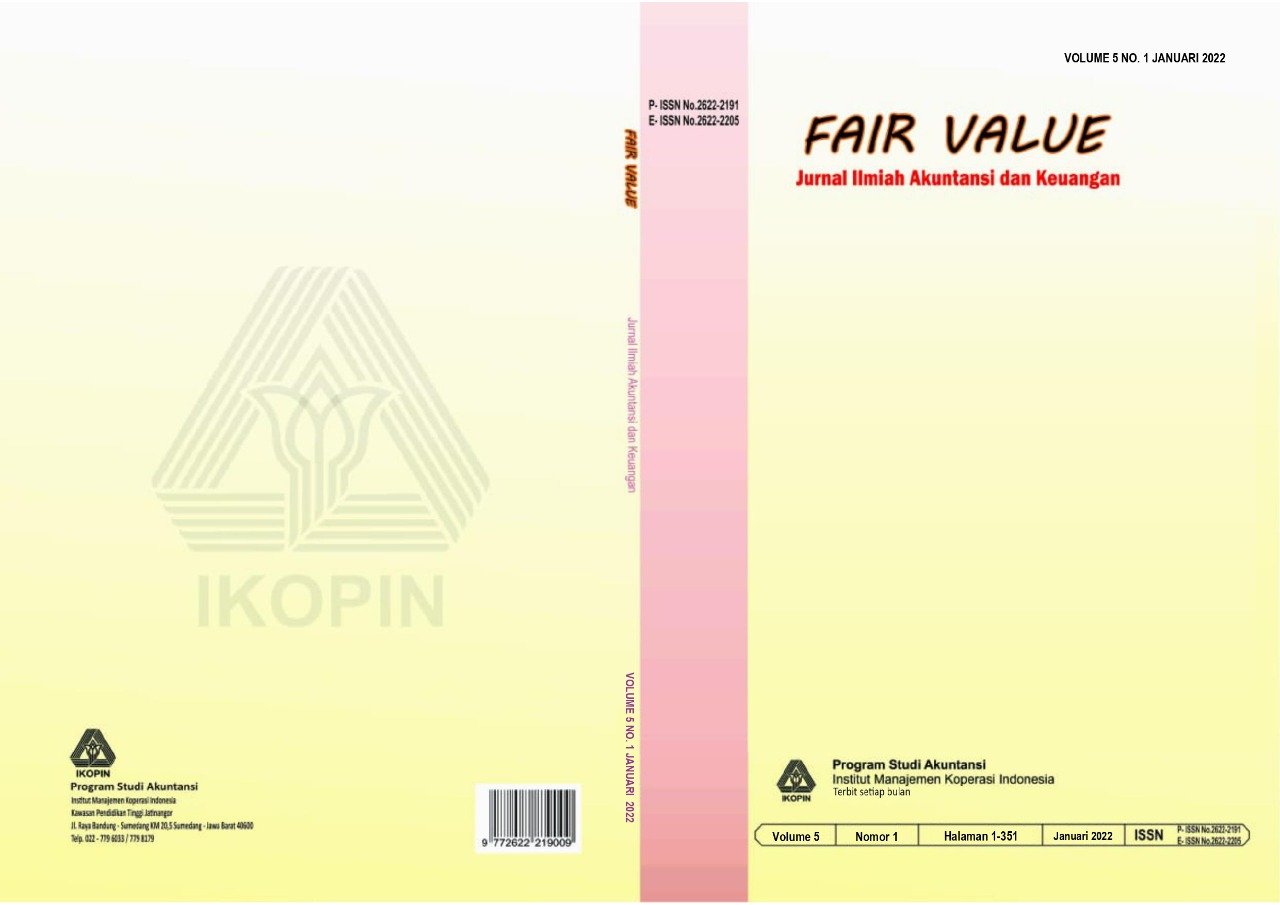Analisis Perbandingan Kinerja Keuangan Perusahaan Sektor Properti Dengan Metode Du Pont & Economic Value Added (EVA) Kasus PT. Ciputra Surya Tbk Tahun 2016 – 2021
Main Article Content
Abstract
This study aims to analyze the company's financial performance with the Du Pont System and EVA approach for the period 2016 to 2021. And what things are related to this approach. The type of data used in this study is quantitative data which is secondary data, in the form of balance sheets and income statements. Based on these data, the research begins with a descriptive analysis of the financial performance of property companies which includes the condition of total asset turnover, net profit margin, return on assets, equity ratio and return on equity. The analysis is continued by using the EVA method which includes Capital, WACC, NOPAT. From the analysis with these two methods, it can be seen how well the company's financial performance is. By using the Du Pont System, it is known that the performance of PT. Ciputra Surya Tbk in terms of cross-sectional analysis of the company's ROE from 2016 to 2021 resulted in 2 positive (+) and 3 negative (-). This means that the company's ROE is still below the industry average. This is due to the ROE of PT. The MDLN (comparison) is positive while the value of Equity and Net Income is negative, which is one of the weaknesses of the Du Pont System. In Time Series the company's ROE was negative (-) in 2016, 2017 and 2018, meaning that the company's financial performance in that period was worse than the previous year. In 2016 and 2018 the company's ROE was positive (+), meaning that the financial performance in that period was better than the previous year. By using the EVA method, it is known that the financial performance of PT. Ciputra Surya Tbk in the period 2016 to 2021 in a Cross Section resulted in a positive EVA value (+). This means that the company's financial performance is better than the industry average (comparison company). By Time Series in 2016, 2017 and 2018, the company produced a negative EVA value (-). This means that the company's financial performance in that period was worse than the previous year. In 20014 and 2015 the company produced a positive EVA value (+), meaning that the company's financial performance in that period was better than the previous year.
Article Details
References
Ardiansyah, A. (2017). Analisis perbandingan kinerja keuangan perusahaan telekomunikasi yang terdaftar di BEI (Studi Kasus PT. XL Axiata Tbk dan PT. Indosat Tbk) (Doctoral dissertation, IAIN Padangsidimpuan).
Bastian, H., Wiagustini, L. P., & Artini, L. G. S. (2018). Pengaruh EVA dan kinerja keuangan terhadap return saham perusahaan tambang batubara di indonesia. Jurnal Buletin Studi Ekonomi, 23(1).
Diwangkara, G. M. (2019). Pengukuran Kinerja Keuangan Perusahaan melalui Metode Economic Value Added dan implikasinya terhadap Nilai Perusahaan (Studi Kasus Pada PT. XYZ) (Doctoral dissertation, STIE Indonesia Banking School).
Erika, A., Nardi, S., Leonardus, S., & A Kadim, K. (2018). The Company’s Performance With The Du Pont System Approach Of Stocks Return And Its Implications On Company Value Of Real Estate And Property Sector Listed In IDX. International Journal of Applied Business and Economic Research (IJABER), 16(1), 29-40.
Husain, T., & Dewi, E. P. (2020). Rasio Keuangan: Studi Komparasi Pada Perusahaan Industri Manufaktur dan Sektor Jasa Yang Melakukan Initial Public Offerings (IPO) Tahun 2018. JIMF (Jurnal Ilmiah Manajemen Forkamma), 3(2).
Jenis, W. (2018). Analisis Kinerja Keuangan Perusahaan Dengan Menggunakan Metode Du Pont System Pada Perusahaan Bumn Manufaktur Sektor Industri Dasar Dan Kimia Subsektor Semen Yang Listing Di Bursa Efek Indonesia Periode 2013-2017 (Doctoral dissertation).
Juliana, E. A. (2018). Analisis Kinerja Keuangan Pt Summarecon Agung Tbk Dan Pt Pakuwon Jati Dengan Menggunakan Metode Du Pont System Dan Analisis Economic Value Added (Eva) Periode 2015-2017. Jurnal Manajemen Bisnis dan Kewirausahaan, 2(5).
Kijewska, A. (2016). Causal analysis of determinants influencing the Economic Value Added (EVA)–a case of Polish entity. Journal of Economics & Management, 26, 52-70.
Male, M. M. G., Amali, L. M., & Dungga, M. F. (2019). Analysis of Financial Performance Using Du Pont System Approach. Jambura Science of Management, 1(2), 27-37.
Novianingrum, R. A. (2021). Penilaian kinerja keuangan menggunakan analisis dupont pada bank syariah dan Bank konvensional tahun 2017-2019 (Doctoral dissertation, Universitas Muhammadiyah Surakarta).
Nurapiah, D., Sucipto, M. C., & Suryana, E. A. (2021). Analisis Kinerja Keuangan Bank Syariah Dengan Metode DuPont System Pada PT. Bank BRI Syariah Periode 2016-2019. EKSISBANK (Ekonomi Syariah Dan Bisnis Perbankan), 5(2), 202-216.
Obaidat, A. N. (2019). Is economic value added superior to earnings and cash flows in explaining market value added? an empirical study. International journal of business, accounting, & finance, 13(1).
Rohmah, R. N. (2018). Pengaruh Economic Value Added (EVA), Return on Asset (ROA), Current Ratio (CR), Debt to Equity Ratio (DER), dan Total Asset Turn Over (TATO) Terhadap Harga Saham pada Perusahaan Manufaktur yang Terdaftar di Daftar Efek Syariah (Doctoral dissertation, UIN Raden Intan Lampung).
SAPUTRI, S. (2020). ANALISIS KINERJA KEUANGAN DENGAN METODE ECONOMIC VALUE ADDED (EVA) PADA PT INTIKERAMIK ALAMASRI INDUSTRI Tbk PERIODE 2015-2018.
Stehel, V., & Bartuška, L. (2018). An analysis of individual business sectors corporate performance for business owners. ББК 65.050. 2я4 М77, 123.
Sunardi, N. (2018). Analisis Economic Value Added (Eva), Financial Value Added (FVA) Dan Market Value Added (MVA) Dengan Time Series Approach Sebagai Alat Penilaian Kinerja Keuangan (Studi Pada Industri Konstruksi (BUMN) di Indonesia Yang Listing di BEI Tahun 2013-2017). Jurnal SEKURITAS (Saham, Ekonomi, Keuangan dan Investasi), 2(1).

